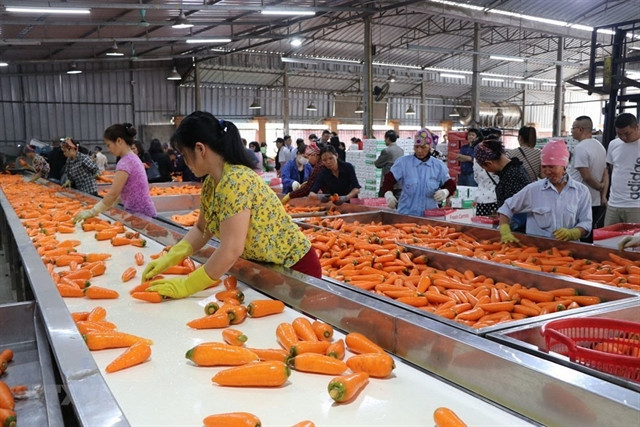 Vietnam's agriculture sector needs to focus on developing raw material production and improving processing capacity. (Photo: VNA)
Vietnam's agriculture sector needs to focus on developing raw material production and improving processing capacity. (Photo: VNA)Manyagricultural products of Vietnam saw exports hit billions of US dollars peryear but production was still heavily reliant on imported raw materials.
Forexample, Vietnam was among the world’s largest cashew exports but stillhas to import around 80 percent of raw cashew for processing, mainly fromIvory Coast, Ghana, Nigeria, Guinea Bissau, Benin, Togo, Burkina Faso andMozambique.
Vietnamalso had to import raw tuna for processing as domestic raw material sources onlymet 30-35 percent of demand.
Accordingto Nguyen Van Nam, former Director of the Vietnam Institute of Trade Researchunder the Ministry of Industry and Trade, globalisation was expandingglobal value chains, meaning that for just one product, different productionstages could be located in different countries, which depended on thecapacity of each country.
Forthe cashew industry, for example, Nam said that while the processing capacityof plants in Vietnam increased significantly, the production of raw cashew didnot expand correspondingly due to limited cultivation land and farmerschoosing other plants with higher added value.
Thismeant that Vietnam must import raw cashew for production, which was a verynormal thing, he said.
However,there would be risks when Vietnam relied on imported raw materials. Therecent Suez Canal blockage heavily affected the import of raw cashew which weremainly from Africa and had to go through this canal. This was an unanticipatedrisk, he pointed out.
Vietnamhad introduced a number of policies to support agricultural production,including measures to support prices or subsidies directly related toproduction quantities.
Namsaid that under the World Trade Organisation, subsidies were subject to limitswith “de minimis” minimal support allowed at 10 percent for developingcountries, including Vietnam.
However,Vietnam had not been successful in implementing subsidies support for theagricultural sector due to limited budget and the lack of an appropriate marketmechanism.
Namsaid it was important to develop comprehensive programmes and strategiesto support farmers and agricultural enterprises to enhance theircompetitiveness, from raw material production to processing capacity as well asdistribution.
Focus on processing
Expertssaid that improving the processing capacity was also essential to increase theadded value for agricultural products.
Statisticsshowed that there were more than 7,500 agricultural processing companies oflarge scale in Vietnam with a total capacity of around 120 million tonnes ofraw materials per year.
Duringthe past three years, 30 agricultural processing projects were constructed withtotal investment capital of 1 billion USD.
However,the processing capacity of Vietnam remained low, Bach Quoc Khang, secretary ofthe Science and Technology Programme for New Rural Development, said.
Onlyfive to 10 percent of the output of vegetables and meat were processed peryear, Khang said.
Theinvestment in processing was not equal to the development of raw materialproduction, he pointed out.
Underthe Prime Minister’s Directive No 25/CT-TTg dated June 4, 2020, Vietnamtargeted to become one among the world’s ten leading countries in terms ofagricultural processing and agricultural product trading centres.
Toachieve this goal, focus must be placed on improving processing andpreservation technology capacity, experts said./.



























